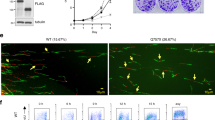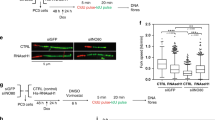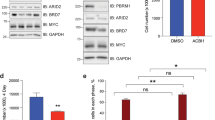Abstract
The INK4/ARF locus encodes three tumour suppressors (p15INK4b, ARF and p16INK4a) and is among the most frequently inactivated loci in human cancer1,2. However, little is known about the mechanisms that govern the expression of this locus. Here we have identified a putative DNA replication origin at the INK4/ARF locus that assembles a multiprotein complex containing Cdc6, Orc2 and MCMs, and that coincides with a conserved noncoding DNA element (regulatory domain RDINK4/ARF). Targeted and localized RNA-interference-induced heterochromatinization of RDINK4/ARF results in transcriptional repression of the locus, revealing that RDINK4/ARF is a relevant transcriptional regulatory element. Cdc6 is overexpressed in human cancers, where it might have roles in addition to DNA replication3,4,5. We have found that high levels of Cdc6 result in RDINK4/ARF-dependent transcriptional repression, recruitment of histone deacetylases and heterochromatinization of the INK4/ARF locus, and a concomitant decrease in the expression of the three tumour suppressors encoded by this locus. This mechanism is reminiscent of the silencing of the mating-type HM loci in yeast by replication factors6. Consistent with its ability to repress the INK4/ARF locus, Cdc6 has cellular immortalization activity and neoplastic transformation capacity in cooperation with oncogenic Ras. Furthermore, human lung carcinomas with high levels of Cdc6 are associated with low levels of p16INK4a. We conclude that aberrant expression of Cdc6 is oncogenic by directly repressing the INK4/ARF locus through the RDINK4/ARF element.
This is a preview of subscription content, access via your institution
Access options
Subscribe to this journal
Receive 51 print issues and online access
$199.00 per year
only $3.90 per issue
Buy this article
- Purchase on Springer Link
- Instant access to full article PDF
Prices may be subject to local taxes which are calculated during checkout




Similar content being viewed by others
References
Lowe, S. W. & Sherr, C. J. Tumor suppression by Ink4a-Arf: progress and puzzles. Curr. Opin. Genet. Dev. 13, 77–83 (2003)
Sherr, C. J. The INK4a/ARF network in tumour suppression. Nature Rev. Mol. Cell Biol. 2, 731–737 (2001)
Karakaidos, P. et al. Overexpression of the replication licensing regulators hCdt1 and hCdc6 characterizes a subset of non-small-cell lung carcinomas: synergistic effect with mutant p53 on tumour growth and chromosomal instability—evidence of E2F-1 transcriptional control over hCdt1. Am. J. Pathol. 165, 1351–1365 (2004)
Semple, J. W. & Duncker, B. P. ORC-associated replication factors as biomarkers for cancer. Biotechnol. Adv. 22, 621–631 (2004)
Murphy, N. et al. p16INK4A, CDC6, and MCM5: predictive biomarkers in cervical preinvasive neoplasia and cervical cancer. J. Clin. Pathol. 58, 525–534 (2005)
Fox, C. A. & McConnell, K. H. Toward biochemical understanding of a transcriptionally silenced chromosomal domain in Saccharomyces cerevisiae. J. Biol. Chem. 280, 8629–8632 (2005)
Pennacchio, L. A. & Rubin, E. M. Genomic strategies to identify mammalian regulatory sequences. Nature Rev. Genet. 2, 100–109 (2001)
Cvetic, C. & Walter, J. C. Eukaryotic origins of DNA replication: could you please be more specific? Semin. Cell Dev. Biol. 16, 343–353 (2005)
Antequera, F. Genomic specification and epigenetic regulation of eukaryotic DNA replication origins. EMBO J. 23, 4365–4370 (2004)
Kawasaki, H. & Taira, K. Induction of DNA methylation and gene silencing by short interfering RNAs in human cells. Nature 431, 211–217 (2004)
Morris, K. V., Chan, S. W., Jacobsen, S. E. & Looney, D. J. Small interfering RNA-induced transcriptional gene silencing in human cells. Science 305, 1289–1292 (2004)
Serrano, M., Lin, A. W., McCurrach, M. E., Beach, D. & Lowe, S. W. Oncogenic ras provokes premature cell senescence associated with accumulation of p53 and p16INK4a. Cell 88, 593–602 (1997)
Stucki, M., Stagljar, I., Jonsson, Z. O. & Hubscher, U. A coordinated interplay: proteins with multiple functions in DNA replication, DNA repair, cell cycle/checkpoint control, and transcription. Prog. Nucleic Acid Res. Mol. Biol. 65, 261–298 (2001)
Abdurashidova, G. et al. Localization of proteins bound to a replication origin of human DNA along the cell cycle. EMBO J. 22, 4294–4303 (2003)
Gonzalez, M. A., Tachibana, K. E., Laskey, R. A. & Coleman, N. Control of DNA replication and its potential clinical exploitation. Nature Rev. Cancer 5, 135–141 (2005)
Frolova, N. S., Schek, N., Tikhmyanova, N. & Coleman, T. R. Xenopus Cdc6 performs separate functions in initiating DNA replication. Mol. Biol. Cell 13, 1298–1312 (2002)
Tao, L., Dong, Z., Leffak, M., Zannis-Hadjopoulos, M. & Price, G. Major DNA replication initiation sites in the c-myc locus in human cells. J. Cell. Biochem. 78, 442–457 (2000)
Araujo, F. D. et al. Identification of initiation sites for DNA replication in the human dnmt1 (DNA-methyltransferase) locus. J. Biol. Chem. 274, 9335–9341 (1999)
Ladenburger, E. M., Keller, C. & Knippers, R. Identification of a binding region for human origin recognition complex proteins 1 and 2 that coincides with an origin of DNA replication. Mol. Cell. Biol. 22, 1036–1048 (2002)
Mutskov, V. & Felsenfeld, G. Silencing of transgene transcription precedes methylation of promoter DNA and histone H3 lysine 9. EMBO J. 23, 138–149 (2004)
Katan-Khaykovich, Y. & Struhl, K. Heterochromatin formation involves changes in histone modifications over multiple cell generations. EMBO J. 24, 2138–2149 (2005)
Wistuba, I. I., Gazdar, A. F. & Minna, J. D. Molecular genetics of small cell lung carcinoma. Semin. Oncol. 28, 3–13 (2001)
Delgado, S., Gomez, M., Bird, A. & Antequera, F. Initiation of DNA replication at CpG islands in mammalian chromosomes. EMBO J. 17, 2426–2435 (1998)
Gonzalez, S., Prives, C. & Cordon-Cardo, C. p73α regulation by Chk1 in response to DNA damage. Mol. Cell. Biol. 23, 8161–8171 (2003)
Mendez, J. & Stillman, B. Chromatin association of human origin recognition complex, cdc6, and minichromosome maintenance proteins during the cell cycle: assembly of prereplication complexes in late mitosis. Mol. Cell. Biol. 20, 8602–8612 (2000)
Ekholm-Reed, S. et al. Deregulation of cyclin E in human cells interferes with prereplication complex assembly. J. Cell Biol. 165, 789–800 (2004)
Arcellana-Panlilio, M. Y. et al. Decreased expression of the INK4 family of cyclin-dependent kinase inhibitors in Wilms tumor. Genes Chromosom. Cancer 29, 63–69 (2000)
Wei, W., Hemmer, R. M. & Sedivy, J. M. Role of p14ARF in replicative and induced senescence of human fibroblasts. Mol. Cell. Biol. 21, 6748–6757 (2001)
Acknowledgements
S.G. was supported by the Human Frontiers Science Program Organization and by the FIS from the Spanish Ministry of Health. Research was supported by the CNIO and by grants from the Spanish Ministry of Education and Science (to M.S., F.A. and J.M.), the European Union project INTACT (to M.S.) and Fundacion Caja Madrid (to J.M.).
Author information
Authors and Affiliations
Corresponding author
Ethics declarations
Competing interests
Reprints and permissions information is available at npg.nature.com/reprintsandpermissions. The authors declare no competing financial interests.
Supplementary information
Supplementary Notes
This file contains the Supplementary Figures, Supplementary Table, Supplementary Methods and additional references. (PDF 682 kb)
Rights and permissions
About this article
Cite this article
Gonzalez, S., Klatt, P., Delgado, S. et al. Oncogenic activity of Cdc6 through repression of the INK4/ARF locus. Nature 440, 702–706 (2006). https://doi.org/10.1038/nature04585
Received:
Accepted:
Issue Date:
DOI: https://doi.org/10.1038/nature04585
This article is cited by
-
CDC6, a key replication licensing factor, is overexpressed and confers poor prognosis in diffuse large B-cell lymphoma
BMC Cancer (2023)
-
Radiation-promoted CDC6 protein stability contributes to radioresistance by regulating senescence and epithelial to mesenchymal transition
Oncogene (2019)
-
Cdc6 contributes to abrogating the G1 checkpoint under hypoxic conditions in HPV E7 expressing cells
Scientific Reports (2017)
-
Correction: Retraction: Oncogenic activity of Cdc6 through repression of the INK4/ARF locus
Nature (2017)
-
Conserved genes and pathways in primary human fibroblast strains undergoing replicative and radiation induced senescence
Biological Research (2016)
Comments
By submitting a comment you agree to abide by our Terms and Community Guidelines. If you find something abusive or that does not comply with our terms or guidelines please flag it as inappropriate.



